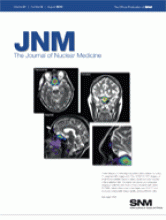Abstract
It is still unclear why some early Parkinson disease (PD) patients with unilateral parkinsonism develop bilateral parkinsonism soon after the diagnosis is made as Hoehn and Yahr (HY) stage 1 and others remain stable for a long time. Here, we examined in vivo changes in the brain dopaminergic system using PET with a dopamine transporter radiotracer, 11C-2-B-carbomethoxy-3B-(4-fluorophenyl) tropane (11C-CFT), to elucidate the pathophysiologic characteristics of the dopamine system in early converters. Methods: Twelve drug-naïve PD patients with HY stage 1 disease and 8 age-matched healthy subjects participated in this study. Clinical evaluation of their parkinsonism was performed monthly until their HY stage 1 (unilateral parkinsonism) disease had become stage 2 (bilateral parkinsonism) disease according to the Unified Parkinson Disease Rating Scale. The endpoint of the follow-up study was the time of the conversion. Region-of-interest analysis was used to examine 11C-CFT binding in the mesocortical (nucleus accumbens, caudate, orbitofrontal cortex) and nigrostriatal (putamen) dopamine projection regions. Multiregression analyses between these PET data and clinical parameters were performed within the PD group. Results: Between-group comparisons showed that, irrespective of the duration of conversion, all PD patients clinically diagnosed at HY stage 1 had a significant reduction in 11C-CFT binding in the bilateral striatum (affected, −46%; unaffected, −35%). Regression analysis showed that the level of 11C-CFT binding in the nucleus accumbens and orbitofrontal cortex on the unaffected side was significantly positively correlated with the conversion interval. This positive correlation indicates that the more severe a dysfunction presents in the mesocortical dopamine system on the seemingly intact side, the more rapidly the parkinsonism proceeds to the intact side (bilateral parkinsonism). Conclusion: The finding of bilateral reduction in the striatal 11C-CFT binding even in HY stage 1 PD patients confirms that molecular changes in the dopamine system precede clinical phenotype, suggesting an advantage of PET for detecting an early abnormality of the disease. The spread of parkinsonism to the unaffected side soon after the diagnosis of HY stage 1 PD may be related to the degree of mesocortical dopamine dysfunction.
- 11C-CFT
- mesocortical dopamine function
- unilateral parkinsonism
- Parkinson disease
- positron emission tomography
- © 2010 by Society of Nuclear Medicine







